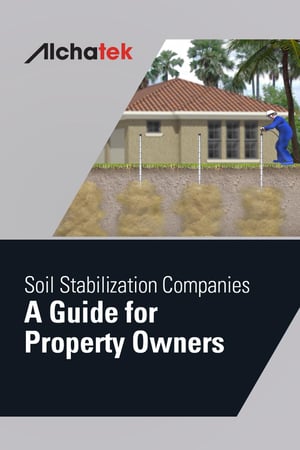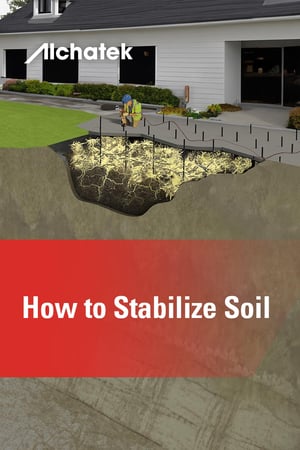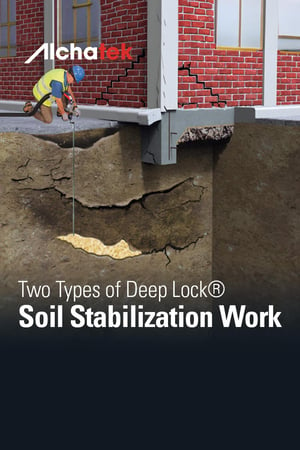
 When it comes to construction and infrastructure development, the stability of soil is paramount. Property owners, managers, and builders must ensure that the ground beneath structures is solid and dependable. In situ soil stabilization with polyurethane foam offers an innovative solution to this challenge.
When it comes to construction and infrastructure development, the stability of soil is paramount. Property owners, managers, and builders must ensure that the ground beneath structures is solid and dependable. In situ soil stabilization with polyurethane foam offers an innovative solution to this challenge.
Understanding In Situ Soil Stabilization
In the context of soil stabilization, "in situ" refers to the process of stabilizing soil directly at the site where it is found, without excavating or removing it. This method is particularly effective when dealing with unstable, eroded, or loose soil around infrastructure. By permeating the soil with ultra-low viscosity polyurethane foam, contractors can fill voids, consolidate soil, and halt water migration.
Polyurethane Foam: A Versatile Solution
One of the key advantages of polyurethane foam is its ability to significantly improve load-bearing capacity. Whether it's a residential driveway or a massive commercial structure, this foam offers a dependable way to reinforce the ground. Moreover, polyurethane foam's versatility extends beyond soil. It can also stabilize rock and gravel substrates, making it a comprehensive solution for various terrains.
Environmentally Friendly Soil Stabilization
In today's environmentally conscious world, sustainability is a top priority. NSF-approved polyurethane foam offers an eco-friendly option for soil stabilization. NSF certification involves rigorous testing and inspection of manufacturing processes. Furthermore, compliance with these standards, aligned with the Safe Water Drinking Act (SDWA), helps prevent water contamination.
Selecting a Qualified Contractor
The success of your soil stabilization project largely depends on the contractor you choose. Look for expertise and experience in polyurethane applications. Also, ensure the contractor uses high-grade materials for effective and durable stabilization. Additionally, review client testimonials and request detailed estimates to gauge reliability and work quality.
A Solid Foundation for Your Future
In situ soil stabilization with polyurethane foam offers a durable solution for unstable soil conditions. Whether it's a residential property, commercial building, or critical infrastructure, polyurethane soil stabilization provides a solid foundation for lasting stability.
Fill out this form or call 404-618-0438 for a contractor referral today!



 Ensuring the stability of your property's slopes is crucial. After all, unstable slopes can cause erosion, damage foundations, and create safety hazards. Fortunately, polyurethane injection is an effective and minimally invasive method for slope stabilization. This article explains how contractors use polyurethane to stabilize slopes.
Ensuring the stability of your property's slopes is crucial. After all, unstable slopes can cause erosion, damage foundations, and create safety hazards. Fortunately, polyurethane injection is an effective and minimally invasive method for slope stabilization. This article explains how contractors use polyurethane to stabilize slopes.
 Pressure grouting, also known as permeation grouting, stabilizes and strengthens weak or loose soil. This process involves injecting a fluid grout mixture under pressure into the ground. As a result, the grout fills voids, cracks, and spaces between soil particles. While cement grout is often associated with pressure grouting, polyurethane grout offers several advantages.
Pressure grouting, also known as permeation grouting, stabilizes and strengthens weak or loose soil. This process involves injecting a fluid grout mixture under pressure into the ground. As a result, the grout fills voids, cracks, and spaces between soil particles. While cement grout is often associated with pressure grouting, polyurethane grout offers several advantages.

 Unstable ground conditions can cause significant damage to structures built on sandy soils. However, sand stabilization with permeation grouting offers a solution to this problem by stabilizing loose sandy soils to create a solid base. This article explains the stabilization process.
Unstable ground conditions can cause significant damage to structures built on sandy soils. However, sand stabilization with permeation grouting offers a solution to this problem by stabilizing loose sandy soils to create a solid base. This article explains the stabilization process.
 If you're searching for a soil stabilization company, you've probably noticed signs of unstable soil around your property, such as cracks or sinking in your patios, walkways, or pool decks. Unstable soil can lead to serious structural issues, but the right soil stabilization contractor can provide a lasting solution. Understanding the soil remediation process is an essential prerequisite for accurately evaluating soil stabilization companies.
If you're searching for a soil stabilization company, you've probably noticed signs of unstable soil around your property, such as cracks or sinking in your patios, walkways, or pool decks. Unstable soil can lead to serious structural issues, but the right soil stabilization contractor can provide a lasting solution. Understanding the soil remediation process is an essential prerequisite for accurately evaluating soil stabilization companies. 
 If you've noticed cracks or sinking in your patios, walkways, pool decks, or other slabs, the problem may lie beneath the surface. In fact, unstable soil around your home can lead to serious structural issues. But don't panic - there is a lasting solution. Keep reading to learn more about how to stabilize soil.
If you've noticed cracks or sinking in your patios, walkways, pool decks, or other slabs, the problem may lie beneath the surface. In fact, unstable soil around your home can lead to serious structural issues. But don't panic - there is a lasting solution. Keep reading to learn more about how to stabilize soil.
 Deep Lock® is an innovative process developed by Alchatek that utilizes high-quality structural polymers to address deep soil issues. This powerful, painless, and rapid solution stabilizes soil at all levels, ensuring long-lasting results with minimal disruption to the property. This article profiles the two main types of Deep Lock® soil stabilization work and the specific situations in which each type is most effective.
Deep Lock® is an innovative process developed by Alchatek that utilizes high-quality structural polymers to address deep soil issues. This powerful, painless, and rapid solution stabilizes soil at all levels, ensuring long-lasting results with minimal disruption to the property. This article profiles the two main types of Deep Lock® soil stabilization work and the specific situations in which each type is most effective.

 Essential Details
Essential Details

 While Alchatek's Deep Lock® process is primarily used on deep soil stabilization jobs, there are specific situations in which deep soil stabilization may be needed to reinforce soil on slab lifting jobs. In cases where slabs are bearing heavy loads, have significantly loose soil underneath, or are located in areas where access is limited, incorporating the Deep Lock® process can help address the underlying soil stability issues. With the addition of the Deep Lock® soil stabilization process, contractors can achieve effective, minimally invasive slab lifting results while simultaneously improving the long-term stability of the foundation.
While Alchatek's Deep Lock® process is primarily used on deep soil stabilization jobs, there are specific situations in which deep soil stabilization may be needed to reinforce soil on slab lifting jobs. In cases where slabs are bearing heavy loads, have significantly loose soil underneath, or are located in areas where access is limited, incorporating the Deep Lock® process can help address the underlying soil stability issues. With the addition of the Deep Lock® soil stabilization process, contractors can achieve effective, minimally invasive slab lifting results while simultaneously improving the long-term stability of the foundation.


